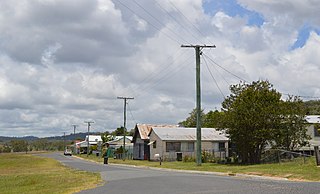
Wallaville is a rural town and locality in the Bundaberg Region, Queensland, Australia. It is 372 kilometres (231 mi) north of the state capital, Brisbane and 43 kilometres (27 mi) south west of the regional centre of Bundaberg. In the 2021 census, the locality of Wallaville had a population of 363 people.

Moore Park Beach is a coastal rural locality in the Bundaberg Region, Queensland, Australia. The coastal town of Moore Park is within the locality.

Kalbar is a rural town and locality in the Scenic Rim Region, Queensland, Australia. In the 2021 census, the locality of Kalbar had a population of 1,246 people.
Bullyard is a small rural town and locality in Bundaberg Region, Queensland, Australia. In the 2021 census, the locality of Bullyard had a population of 206 people.
South Bingera is a rural residential locality in the Bundaberg Region, Queensland, Australia. In the 2021 census, South Bingera had a population of 674 people.

Oakwood is a rural locality in the Bundaberg Region, Queensland, Australia. In the 2021 census, Oakwood had a population of 364 people.
Sharon is a rural locality in the Bundaberg Region, Queensland, Australia. In the 2021 census, Sharon had a population of 1,209 people.

Alloway is a rural locality in the Bundaberg Region, Queensland, Australia. In the 2021 census, Alloway had a population of 488 people.

Kalpowar is a town in the North Burnett Region and a locality split between the North Burnett Region and the Bundaberg Region, in Queensland, Australia. In the 2021 census, the locality of Kalpowar had a population of 53 people.
Bungadoo is a rural locality in the Bundaberg Region, Queensland, Australia. The area was formerly known as Albionville. In the 2021 census, Bungadoo had a population of 342 people.
Elliott is a rural locality in the Bundaberg Region, Queensland, Australia. In the 2021 census, Elliott had a population of 156 people.

Bucca is a rural locality in the Bundaberg Region, Queensland, Australia. In the 2021 census, Bucca had a population of 1,063 people.
Gaeta is a rural locality in the Bundaberg Region, Queensland, Australia. In the 2021 census, Gaeta had a population of 134 people.
Morganville is a rural locality in the Bundaberg Region, Queensland, Australia.
Pine Creek is a rural locality in the Bundaberg Region, Queensland, Australia. In the 2021 census, Pine Creek had a population of 258 people.
Gilla is a rural locality in the Toowoomba Region, Queensland, Australia. In the 2021 census, Gilla had a population of 61 people.
Monduran is a rural locality in the Bundaberg Region, Queensland, Australia. In the 2021 census, Monduran had a population of 84 people.
Moorland is a rural locality in the Bundaberg Region, Queensland, Australia. In the 2021 census, Moorland had a population of 284 people.
Lake Monduran is a rural locality in the Bundaberg Region, Queensland, Australia. In the 2021 census, Lake Monduran had "no people or a very low population".
Bundaberg–Gin Gin Road is a state-controlled district road in the Bundaberg region of Queensland, Australia. It runs from Bundaberg–Bargara Road in Bundaberg Central to the Bruce Highway in Gin Gin, a distance of 48.4 kilometres (30.1 mi). It is signed as State Route 3.









